Removal of wisdom teeth. How it's done?

Dear friends, last time we talked about what kind of wisdom teeth are, when they need to be removed and when they are not. And today I will tell you in detail and in all details how the removal of “sentenced” teeth takes place directly. With pictures. Therefore, I recommend especially impressionable people and pregnant women to press the key combination "Ctrl +". Joke.
Where does the removal of the 8th, and in principle, any other tooth begin?
With anesthesia.
So:
')
Anesthesia (pain relief)

To minimize discomfort during the injection, it is necessary to treat the injection site with a special anesthetic gel. This is the so-called application anesthesia. It is very often used in pediatric dentistry, but we also use it in work with adults. As practice shows, the discomfort becomes less, and her taste is pleasant ... at least some joy.
When removing the teeth of the upper jaw, as a rule, a simple infiltration by the anesthetic of the region of the tooth to be removed is sufficient. It is performed using a special syringe with specially selected anesthetics and is called infiltration.

When removing teeth in the lower jaw, infiltration anesthesia is usually not enough (with the exception of the frontal group of teeth, from canine to canine). Therefore, the technique of anesthesia varies somewhat - anesthetic with a long but very thin needle is fed directly to the nerve bundle, which is responsible for the innervation of the desired areas. Such anesthesia allows you to "turn off" the sensitivity not only in the area of the tooth being removed, but also the lips, chin, part of the tongue, etc.
It should be noted that during and immediately after anesthesia, a number of interesting phenomena can occur - increased heart rate, trembling of the extremities, and an inexplicable feeling of anxiety. Many patients start to panic about this. And do not panic! These are side effects of most modern anesthetics, they pass on their own within 10-15 minutes.
Well, - anesthesia is done! Now you need to make sure - is it successful?
The places that should ideally be numb are listed above. Also, with the help of a special tool and pressure on the gum in the area of the operated tooth, we determine whether there is still pain or not. The only thing that should be felt is the feeling that “something” is touching the gum. That is, the tactile sensations are still preserved, but the pain is already absent.
And then our actions differ depending on what type of wisdom tooth we are dealing with.

Impacted wisdom tooth
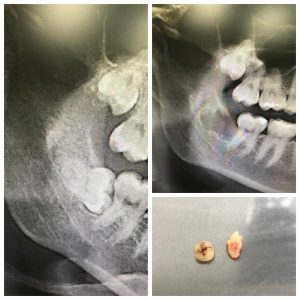

It is usually the most difficult to remove the eight of all the rest.
We have already anesthetized the surgical field. What's next?
He's under the gum! So - we take in the hands of a scalpel, and make a delicate incision in the area of the tooth to be removed. This creates access to the wisdom tooth to be removed. It stands out from the surrounding tissues with the help of special tools, and now we can visually assess its position and choose a removal technique.
If the tooth is not cut, it means that something is interfering with it. This “something” will also interfere with its removal, and this “something” can be a neighboring tooth, a bone protrusion, etc. However, you won’t delete the seven to get to the wisdom tooth, right?
Therefore, we divide the tooth into parts. Using a special tip with a mill speed of 150,000 revolutions per minute is no longer a simple angular, but not yet turbine. The latter, by the way, is extremely undesirable to use for the extraction of teeth, because at 500,000 revolutions per minute it is easy to burn everything with hellish flames, and to blow emphysema on the half-face with air from the cooling nozzle. In general, you need to choose the right tools for removal, there are no trifles and compromises here and there cannot be. And it is worth thinking a hundred times before removing such problem teeth in the dental office for one chair at a rural club on the “Half-empty Zakroma” collective farm.
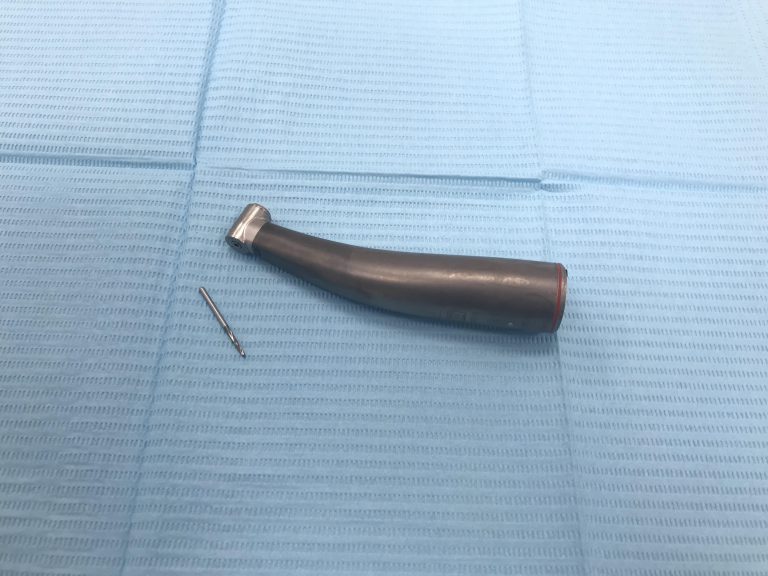
Special surgical tip for wisdom teeth removal. Rotates with the desired frequency, provides the right torque, does not burn tissue and does not inflate emphysema. In surgery, we use only such devices.
So, we divide the tooth into 2-3 parts in order to remove it accurately and low-impact for surrounding tissues. And the teeth are usually removed with the help of an “elevator” (in the picture on the left). Nippers, which are all associated with removal, are in fact extremely rarely used.
Well, the tooth is removed. Next, we carry out the cleaning of the tooth from the "sawdust" and small fragments of the tooth that could remain. With the help of curettes.
When removing wisdom teeth, no biomaterials are used, the hole is independently filled with a blood clot, which is quite enough for normal healing.
Moreover, “pushing” the biomaterials into the well may complicate the healing process, so let the regeneration process take place naturally and simply, and not fancifully, as some doctors suggest.

The impacted teeth are removed mainly by the elevator, and not by forceps, as many used to think.
Clot in place. Then we reduce the edges of the wound and put stitches in order to prevent food from getting into the wound, not to bleed too much, and rather heal. But at the same time, the stitches should not be tight, because the wound can bleed significantly the first day. And if you do not create an outflow, often develop edema.
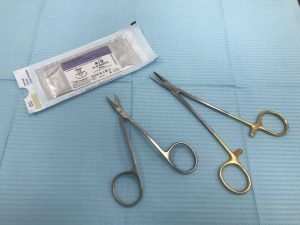
After removal, resorbable (absorbable) sutures are applied to the well, most often they do not need to be removed. But all individually.
Pure tooth
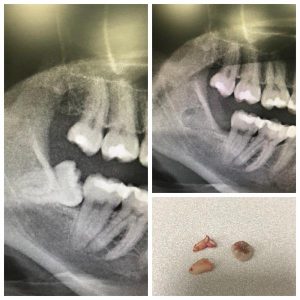
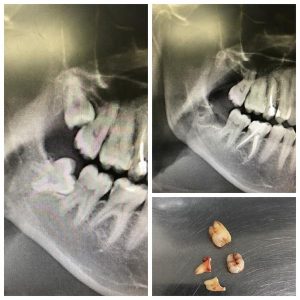
In principle, the procedure for the removal of such a tooth is no different from the removal of a fully impacted tooth. But, as a rule, it is a little easier because the tooth is not so deep. The main stages, in essence, are the same: anesthesia, creation of access to the tooth (and, sometimes, it is possible to do without incisions), fragmentation (division of a tooth into parts) and, in fact, removal of the teeth into parts.
After removal of the lower polyurethinized tooth, sutures are superimposed on the well; in the area of the upper wisdom teeth, suturing is not always necessary.
Dystopian tooth


Removal of such teeth can be called a simpler case compared to others, but only if the tooth has one straight root. Then the removal can go quite quickly. But such clinical cases are extremely rare. And looking at the picture, we see hooks, but not roots, which, with proper pressure, can simply break. The roots are usually 2, and in this case we just need to separate one root from another with the help of the same tool - the “raising” tip. And carefully each of the roots to get separately. The beginning and end of the removal of such teeth is the same as for all the others.
Completely cut tooth and standing in a tooth row
As we found out from the previous article , we leave such teeth in place. They just need care and observation, as is the case with ordinary teeth.
And sometimes ...
... that wisdom teeth block neighboring sevens and prevent them from erupting normally. In such cases, patients come to the surgeon in the direction of the orthodontist.

Of course, the germ of the eighth tooth must be removed. This is a fairly simple and relatively comfortable operation.
Look at the pictures. Between the upper and lower - the difference of three weeks. It is clearly seen from them that after the removal of the buds of the eightes and the “unlocking”, the seventh teeth immediately went into growth.
The wisdom tooth is removed. The patient is pleased. But the fun is yet to come. Namely - the postoperative period.
After removing 8 teeth you need to follow strict recommendations:
- In no case do not rinse or warm the area of the extracted tooth. Forget and do not listen to instructions like "you need to rinse with tincture of shark fins and mammoth tusks." Not! This can not be done. Why? And all because the same blood clot, which, as we have already learned, must remain in the hole and protect it, can be easily rinsed out. And again we will return all to the same inflammation and, accordingly, to a long healing.
- Eliminate physical exertion, at least for 2-3 days . For what? And in order that, under loadings, the pressure rises (yes, yes, yes, even Arnold Schwarzenegger and Rocco Siffredi !!!), and, despite the fact that the clot is not finalized yet, the wound can begin to pee, and badly heal up.
- Also exclude the general overheating of the body . Saunas, baths, hot tubs - not. All this also contributes to bleeding.
- Do not eat until the anesthesia is completely gone . Otherwise, the risk that you can bite your lip, tongue or cheek hard enough and not notice it is extremely high. It usually takes about 2-3 hours. And ideally - cold, hunger, peace for the first couple of days.
- But when you have reached a meal , you only need to chew on the side opposite to the removal in order to minimize the ingress of food into the hole.
- Do not forget about brushing your teeth! Teeth must be cleaned necessarily, preferably with a soft toothbrush, in order not to injure the area of the extracted tooth. And do not forget that the tooth is no longer there, so in this area we work with a brush especially carefully. AND! Sure to! DO NOT TRY to peel off the white patina that can build up the gum in the area of the extracted tooth. This is NOT pus! This is FIBRIN! Protein, whose presence indicates the normal healing of the hole.
- Also, after the removal of the tooth ice is issued . It is recommended to apply it to the cheek in the area of the extracted tooth during the remaining day. Approximately 15-20 minutes every hour. Still in order to minimize swelling. But it is not necessary to get involved too much in order not to freeze the throat and lymph nodes (if the ice is not kept where it is necessary, or where it is necessary, but too long).
In addition to these recommendations, medications are also prescribed , the so-called anti-bacterial and anti-inflammatory therapy. This is due to the fact that the area of 8 teeth is extremely easy to inflame, but we would not want it. Along with the intake of antibiotics, natural yogurts and other dairy products go great - do not forget to maintain the intestinal microflora.
If the removal was carried out correctly, and the patient complied with all the recommendations and performed the prescription of the doctor, then the risks of postoperative complications are extremely small.
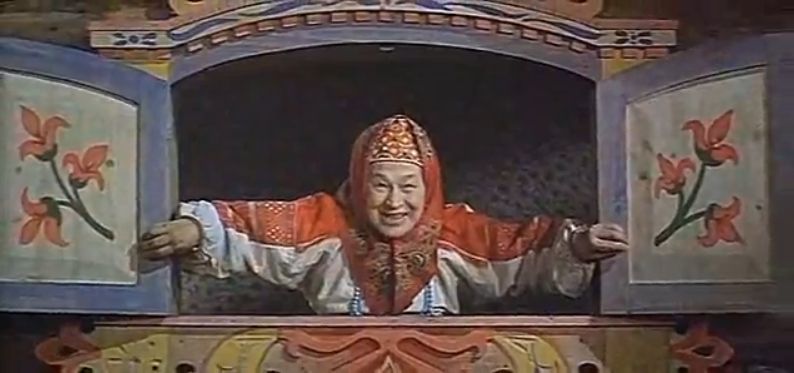
Stay tuned!
Sincerely, Andrei Dashkov.
Source: https://habr.com/ru/post/455499/
All Articles